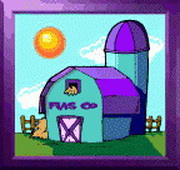Panir / Paneer
aka
Queso Blanco
I must say, I believe my favorite cheese for home cheesemaking is Panir (pan eer) (also spelled Paneer) or Queso Blanco (kay'so blan'ko). Why is it my favorite, you may ask? Well, for one, because it's so doggone easy to make. Secondly, there is so much you can do with it. Panir, as it's known in India, is also called Queso Blanco ("white cheese") in Latin America. Don't confuse Queso Blanco with Queso Fresco (fresh cheese) just because they have "queso" (which is Spanish for cheese) in their names, they are quite different kinds of cheese. Panir/Queso Blanco is perfect for "first timers" but even the more advanced "cheeseheads" should try it (or try it again). It's quick and simple to make, and takes very little special equipment. It is a bland cheese that is kind of rubbery and will not melt. "Why the heck would I want to make that?" You might ask, "That doesn't sound good at all." Well, put away your preconceived notions about what cheese should be: melty Mozzarella pizza or tangy Cheddar snacks; and think of cheese as what it could be: a wonderfully tasty food source and excellent meat extender.
I use more Panir any other cheese I make (and I make a lot of cheese). It is one of the few cheeses that freezes well, so I can stock up for the dry times. It is delicious... it's just not a "table" cheese. Though, actually, sprinkled with seasoned salt, it's not bad as a snack either.
Panir is sometimes called "Vinegar Cheese" because vinegar is used as an "acid precipitant", that is, the acid of the vinegar (along with higher heat) makes the curds separate from the whey. Lemon juice or lime juice can be used as the acid precipitant also. However, vinegar is easier, more reliable and the end results are pretty much the same. The cheese cannot be made using low temperatures.
Panir / Queso Blanco Recipe
You can use either goat or cow milk for this cheese. You can use as much milk as you'd like. You can use 1 gallon, or two gallons, or three gallons. It just depends on how much milk you have, and how big your pot is. Don't use an aluminum pot.
Over direct heat, warm the milk to 183°- 185° (not any higher), and maintain that temperature for 10 minutes. Stir it often to keep it from scorching. If it does scorch, use a stainless steel scrubby to clean your pot later.
With the milk still on the heat, while stirring, add about 1/4 Cup of white vinegar per gallon of milk. I find the taste is better with white vinegar than cider vinegar. To be honest, I don't even measure the vinegar, I just pour in a glug, stir, look, pour in a glug, stir, etc. until the curd separates. The separation should happen right away. When the curd separates cleanly from the whey (it will look like very fine, white particles floating in the greenish whey), pour it into a cheesecloth lined colander. I put the colander over another pot, to save the whey for later use. Use real cheesemaking cheesecloth here, not the stuff you can buy at the grocery store.
Tie the corners of the cloth together and hang the bag to drain for a few hours. Refrigerate your cheese after it has drained. It will keep for a couple of weeks.
Now that you have this rubbery ball of cheese, what do you do with it? Panir is like tofu: it will take on the flavor of the food it is cooked with. Just cut it into bite-sized cubes and throw it into chili or spaghetti. You can cook the noodles in the leftover whey. You will need to cook them a little longer than usual; test to make sure they're done to your liking. I love pasta cooked in whey. I always save whey just for this purpose. Try serving your chili over vermicelli cooked in whey, topped with a sprinkle of cheese, some sprouts and a dollop of yogurt (goat of course).
You could use Panir as a meat extender/replacement. Since we are vegetarian, we use a lot of Panir. When you make taco meat, I cut it up in tiny cubes and simmer it with the meat for about an hour. I make "chick'n a la king" using cubes of Panir instead of meat. A quick dinner is mac'n cheese, made from a box, but also add onions, Panir cubes, peas and use buttermilk in place of regular milk.
You can marinade the Panir and throw it on top of salads or use it in stir-fry. Panir is really in its element when used in curry. Serve the curry over rice cooked with whey instead of water and add a handful of raisins and a clove to the rice as well, to make it really authentic.
There are endless uses for Panir, so make some of this quick and easy cheese and experiment for yourself.
